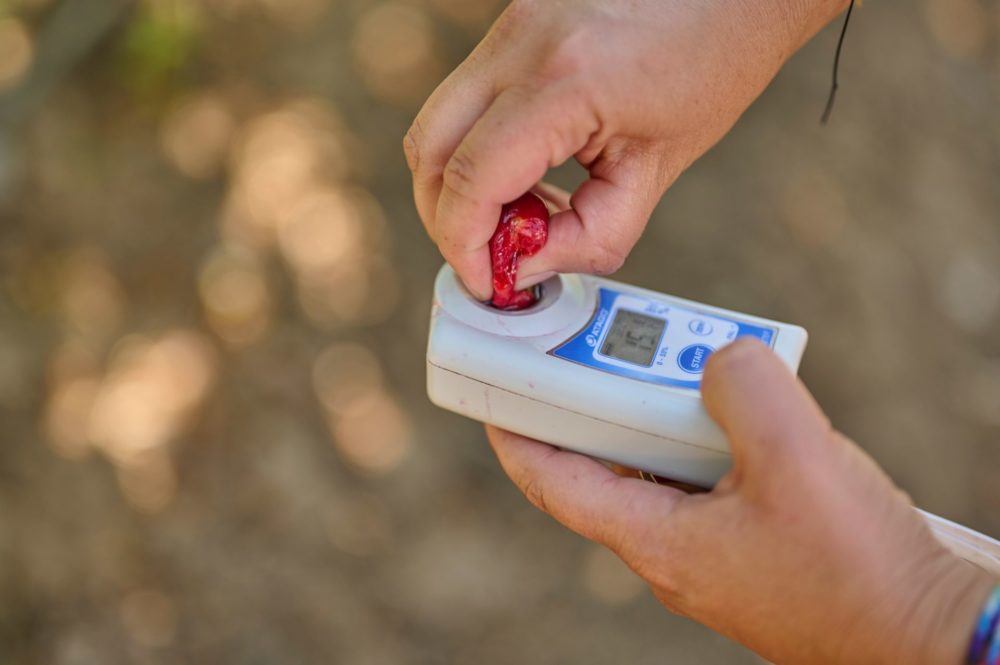The team at International Fruit Genetics (IFG) is no stranger to ‘customizing’ crops. The Bakersfield, California-based company uses natural breeding techniques to come up with its cultivars, which it then licenses to growers and fruit brands.
Founded by fruit geneticist and former US Department of Agriculture researcher David Cain in 2001, IFG set out on a mission to develop sweeter and larger table grape cultivars – culminating in the creation of its flagship Cotton Candy grape, which went on sale in 2011.
More recently, IFG has been tackling a new and more pressing challenge for the fruit industry: climate change.
In advance of the company’s planned sale to AM Fresh and merger with private equity-backed Special New Fruit Licensing, its team has come up with a range of ‘low-chill’ cherry varieties that can thrive in warmer climates; along with other technologies and practices to assist its licensees. SNFL counts veteran agrifood private equity firm Paine Schwartz as a shareholder.
AFN chatted to IFG’s CEO Andy Higgins about climate change’s impact on the global fruit industry – and how players like IFG are responding to the challenge with tech.
AFN: In general, how would you say climate change is affecting global fruit production?
Climate change is affecting many different regions around the globe, and the shift in weather is impacting fruit production. Unprecedented heat in the Western US and Canada has caused severe drought and the threat of severe wildfires. The smoke from fires has contributed to lower levels of light, smoke damage to crops, and retention of humidity during key production times of the year.
Climate change is also [causing] an increase in the intensity and frequency of rains out of the usual season. Heavy rains in recent years, right at harvest, have significantly impacted crops in Chile, for example.
We see climate change impacting where and how crops can be effectively grown. It affects the locations where products can be grown today and in the future, thereby impacting the capacity to meet retailer and wholesaler programs.
Growers are utilizing more complex production techniques to deliver crops of consistently good quality, including increased use of crop covers, a form of protected agriculture. As such, IFG is breeding new varieties of fruit that will grow in warmer climates, and in climates with increased rains and humidity during key times of production.
As the planet changes, there is the possibility that we will see less fruit production. IFG is focused on breeding varieties that ensure consistent cropping in a changing climate.
For instance: some areas in Europe have begun moving wine grape vineyards further north or to a higher elevation, adjusting to the planet’s changing climate.
Fruits and vegetables are living organisms that respond to warm and cold temperature changes. Anything that will make significant changes to the environment will have considerable impacts on agriculture. It’s not only about extremely hot and cold weather or having enough water for irrigation, but also about individual events, such as flooding, storms, and wildfires damaging entire fields of crops in one swoop.
AFN: What are the biggest challenges that IFG and other fruit growers in California are experiencing as a result of climate change? And how are you overcoming them?
Unprecedented heat in the Western US and Canada have caused severe drought and the threat of severe wildfires – which can result in smoke damage, quality degradation due to light, and other considerations.
From breeding to growing and packing, there are different efforts in place to combat the effects of climate change. On the breeding side, efforts are being made to develop varieties that can tolerate rain and heat at varying stages of the production cycle. IFG is working on this for our table grape and cherry crops, and other fruit breeders are working on the same for crops such as apples and pears.
In addition, IFG is working to understand and incorporate the importance of protected agriculture in long-term crop production. These efforts may be enough to protect against hot or cold temperatures or drought, but will not save crops from being destroyed by extreme weather events such as wildfires, storms, or floods.
AFN: How do you see commercial fruit-growing operations adopting new practices and technology to try to solve for these issues?
Table grapes themselves are more heat tolerant, and IFG’s breeding program has used the most recent heatwave to screen our varieties for heat tolerance. However, there is still a maximum amount of heat that fruit can tolerate, and as climate change continues to alter the environment, it will affect global agriculture.
IFG is unique in that we have ‘boots on the ground’ in each growing region throughout the world. We have technical managers in each country who work to identify any new practices or technologies that can be used to produce the best grapes and cherries possible. These growing recommendations are then provided to our licensees in each of their respective regions to ensure that we are helping our partners be as successful as possible.
We also utilize phenolic stages, and work with breeding to alter or minimize the impact of outside factors during key growing periods. For example, an earlier-maturing raisin variety will allow the raisin crop to be harvested and processed before the risks of late summer rains.
Growers are also implementing new irrigation system technology to be more efficient, while also protecting their crops from the rapidly changing environment. They are utilizing remote and computer-controlled soil humidity sensors, reflective covers to reduce water evaporation, shade nets to protect the crops from excessive sun exposure, and even rain covers to protect the fruit from rainstorms.
AFN: Can you explain a little more about the ‘low chill’ cherry – how it works, how it was created, and where the concept came from?
Traditionally, a lot of chill hours are required to grow a great cherry. Most cherry trees have required 800 to 1,000 hours of temperatures ranging from 35° to 42° Fahrenheit [during their growth to produce optimal fruit.] IFG has created varieties of cherries that need less than half that much.
The other aspect is selecting and crossbreeding varieties that can survive months of high heat; and ideally, put out fruit that ripens ahead of other varieties. In addition, we want varieties that are less susceptible to stress damage from soaring temperatures in May and early June.
We [also want to] make sure that the fruit has the firm texture consumers demand, good flavor, an attractive appearance, and the ability to withstand weeks in a shipping container bound for different regions around the globe.
The parentage in the breeding program is quite diverse, and the low-chill trait comes from a tropical Prunus species that needed to be crossed again and again into material with higher fruit quality and grower-friendly orchard adaptability.
We are continuing our evaluations to determine which [of our varieties] will consistently produce outstanding fruit, especially in the warmest areas of cherry-growing regions. We already have successful commercial plantings in several countries such as Chile, South Africa, Spain, and Australia with 10 of our [intellectual property] protected varieties.
AFN: What are the implications of ‘low chill’ fruit varieties for producers and consumers, in your view?
Due to climate change and recent developments in fruit breeding programs, the industry is seeing increasing growth of planting in regions where certain fruit varieties were not grown at all in the past, as farmers try to avoid planting in higher-risk areas. Jalisco in Mexico or Piura in Peru are examples of developing table grape regions, and this type of growth is also evident in other crops, including blueberries and cherries, with the recent introduction of low-chill varieties.
As for cherries, new low-chill varieties afford us the opportunity to grow and expand cherry development in such places as Israel and Egypt – regions not traditionally known for cherries.
Growers will undertake the enormous task of moving their fruit to new areas if the heat or drought is too difficult for production. Conversely, if the region cannot provide the necessary chill requirements or secure water supply, we expect growers to move to nontraditional growing areas, as evident in the regions where IFG’s cherry varieties are expanding.

















Sponsored
International Fresh Produce Association launches year 3 of its produce accelerator